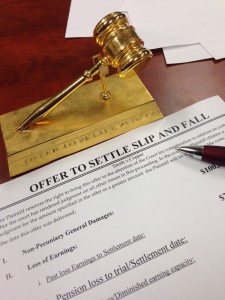
In this offer to settle slip and fall case the court used its discretion and allowed a claimant that was found 50 % at fault to recover 65% of her costs. The claimant was also awarded double costs after the insurance comany refused to accept a reasonable offer of settlement almost a month before trial ( Tenhunen v. Tenhunen,2015 BCSC 955). However, for slip and fall cases the Negligence Act says that a parties liability to pay court costs in a personal injury lawsuit is in the same proportion as their liability to make good the damage or loss, unless otherwise ordered.
The claimant slipped and fell on a ramp outside a rental home in Sooke, B.C. The Supreme Court found that the defendant failed to take reasonable care for the safety of those, including the claimant by building too much slope into the ramp, not providing a guard or handrail on the outside, and not making some effort to enhance traction in the 6 years before the injury. The court also found that the claimant failed to take reasonable care for her own safety because she knew there was no outside guard or handrail when she stepped onto the lower ramp. The judge apportioned liability 50% to the defendant, and 50% to the claimant.
The claimants damages were assessed at $250,182.38 before apportionment for contributory negligence. The claimant had offered to settle her claims for $100,000 plus costs In the weeks before the trail a new offer in which she said she would accept $80,000 plus costs was made. Again, this offer was rejected.
The claimant sought 100% of her costs in spite of the division of liability, asking that the court exercise its discretion under s. 3(1) of the Negligence Act, R.S.B.C. 1996, c. 333. The claimant also sought double costs after her offer of $100,000 plus costs.
In awarding the claimant 65% costs instead of 50%, the judge developed a list of factors from which we have developed the following helpful checklist for the court to exercise its discretion under s. 3(1) of the Negligence Act:
1. The serious nature of the injury;
2. The denial of liability;
3. The length and complexity of trial;
4. The size of the Damages awarded;
5. The amount of costs incurred by the claimant in getting to trial;
6. The amount sought compared with the amount recovered; and
7. The defendants’ degree of success on a claim of contributory negligence.
As to Double costs it was clear that the claimant’s offers of settlement ought reasonably to have been accepted. It was less than the claimant achieved through trial. The Court assumed that a party able to retain experienced lawyer to conduct litigation through a five day trial and beyond, and to offer to settle for $80,000 before trial, was able to pay double costs.
The judge ordered the defendant to pay the claimant 65% of her costs at Scale B to the date of her first offer to settle, and 65% doubled from thereafter to the present, plus 65% of her disbursements throughout.
Post by Personal Injury Lawyer in Vancouver Mr. Renn A. Holness, B.A., LL.B.
